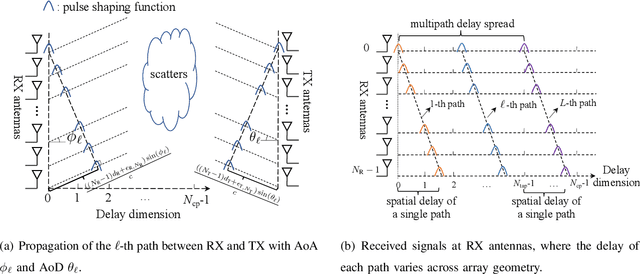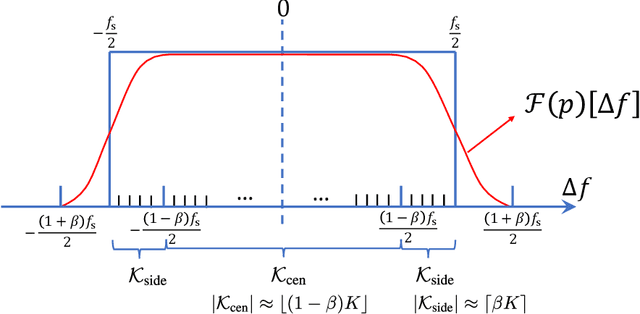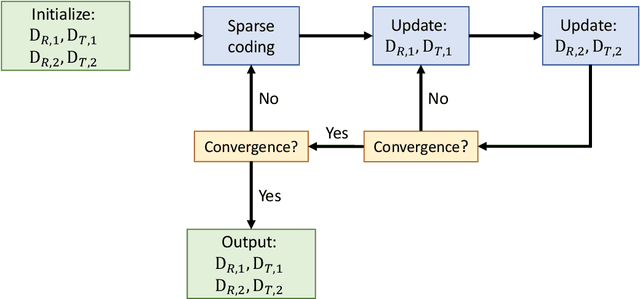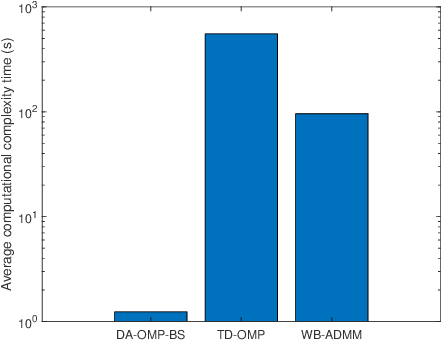Nuria González-Prelcic
atlanTTic Research Center, Universidade de Vigo, Vigo, Spain
A Hybrid Model/Data-Driven Solution to Channel, Position and Orientation Tracking in mmWave Vehicular Systems
Mar 07, 2025Abstract:Channel tracking in millimeter wave (mmWave) vehicular systems is crucial for maintaining robust vehicle-to-infrastructure (V2I) communication links, which can be leveraged to achieve high accuracy vehicle position and orientation tracking as a byproduct of communication. While prior work tends to simplify the system model by omitting critical system factors such as clock offsets, filtering effects, antenna array orientation offsets, and channel estimation errors, we address the challenges of a practical mmWave multiple-input multiple-output (MIMO) communication system between a single base station (BS) and a vehicle while tracking the vehicle's position and orientation (PO) considering realistic driving behaviors. We first develop a channel tracking algorithm based on multidimensional orthogonal matching pursuit (MOMP) with factoring (F-MOMP) to reduce computational complexity and enable high-resolution channel estimates during the tracking stage, suitable for PO estimation. Then, we develop a network called VO-ChAT (Vehicle Orientation-Channel Attention for orientation Tracking), which processes the channel estimate sequence for orientation prediction. Afterward, a weighted least squares (WLS) problem that exploits the channel geometry is formulated to create an initial estimate of the vehicle's 2D position. A second network named VP-ChAT (Vehicle Position-Channel Attention for position Tracking) refines the geometric position estimate. VP-ChAT is a Transformer inspired network processing the historical channel and position estimates to provide the correction for the initial geometric position estimate. The proposed solution is evaluated using raytracing generated channels in an urban canyon environment. For 80% of the cases it achieves a 2D position tracking accuracy of 26 cm while orientation errors are kept below 0.5 degree.
Multicarrier ISAC: Advances in Waveform Design, Signal Processing and Learning under Non-Idealities
Jun 26, 2024Abstract:This paper addresses the topic of integrated sensing and communications (ISAC) in 5G and emerging 6G wireless networks. ISAC systems operate within shared, congested or even contested spectrum, aiming to deliver high performance in both wireless communications and radio frequency (RF) sensing. The expected benefits include more efficient utilization of spectrum, power, hardware (HW) and antenna resources. Focusing on multicarrier (MC) systems, which represent the most widely used communication waveforms, it explores the co-design and optimization of waveforms alongside multiantenna transceiver signal processing for communications and both monostatic and bistatic sensing applications of ISAC. Moreover, techniques of high practical relevance for overcoming and even harnessing challenges posed by non-idealities in actual transceiver implementations are considered. To operate in highly dynamic radio environments and target scenarios, both model-based structured optimization and learning-based methodologies for ISAC systems are covered, assessing their adaptability and learning capabilities under real-world conditions. The paper presents trade-offs in communication-centric and radar-sensing-centric approaches, aiming for an optimized balance in densely used spectrum.
Integrated Monostatic Sensing and Full-Duplex Multiuser Communication for mmWave Systems
May 15, 2024Abstract:In this paper, we propose a hybrid precoding/combining framework for communication-centric integrated sensing and full-duplex (FD) communication operating at mmWave bands. The designed precoders and combiners enable multiuser (MU) FD communication while simultaneously supporting monostatic sensing in a frequency-selective setting. The joint design of precoders and combiners involves the mitigation of self-interference (SI) caused by simultaneous transmission and reception at the FD base station (BS). Additionally, MU interference needs to be handled by the precoder/combiner design. The resulting optimization problem involves non-convex constraints since hybrid analog/digital architectures utilize networks of phase shifters. To solve the proposed problem, we separate the optimization of each precoder/combiner, and design each one of them while fixing the others. The precoders at the FD BS are designed by reformulating the communication and sensing constraints as signal-to-leakage-plus-noise ratio (SLNR) maximization problems that consider SI and MU interference as leakage. Furthermore, we design the frequency-flat analog combiner such that the residual SI at the FD BS is minimized under communication and sensing gain constraints. Finally, we design an interference-aware digital combining stage that separates MU signals and target reflections. The communication performance and sensing results show that the proposed framework efficiently supports both functionalities simultaneously.
The Integrated Sensing and Communication Revolution for 6G: Vision, Techniques, and Applications
May 03, 2024



Abstract:Future wireless networks will integrate sensing, learning and communication to provide new services beyond communication and to become more resilient. Sensors at the network infrastructure, sensors on the user equipment, and the sensing capability of the communication signal itself provide a new source of data that connects the physical and radio frequency environments. A wireless network that harnesses all these sensing data can not only enable additional sensing services, but also become more resilient to channel-dependent effects like blockage and better support adaptation in dynamic environments as networks reconfigure. In this paper, we provide a vision for integrated sensing and communication (ISAC) networks and an overview of how signal processing, optimization and machine learning techniques can be leveraged to make them a reality in the context of 6G. We also include some examples of the performance of several of these strategies when evaluated using a simulation framework based on a combination of ray tracing measurements and mathematical models that mix the digital and physical worlds.
Hybrid Precoding and Combining for mmWave Full-Duplex Joint Radar and Communication Systems under Self-Interference
Nov 25, 2023



Abstract:In the context of integrated sensing and communication (ISAC), a full-duplex (FD) transceiver can operate as a monostatic radar while maintaining communication capabilities. This paper investigates the design of precoders and combiners for a joint radar and communication (JRC) system at mmWave frequencies. The primary goals of the design are to minimize self-interference (SI) caused by FD operation, while guaranteeing certain performance in terms of some sensing and communication metrics, as well as taking into account the hardware limitations coming from a hybrid MIMO architecture. Specifically, we introduce a generalized eigenvalue-based precoder that takes into account downlink user rate, radar gain, and SI suppression. Since the hybrid analog/digital architecture degrades the SI suppression capability of the precoder, we further enhance SI suppression with the analog combiner. Our numerical results demonstrate that the proposed architecture achieves the required radar gain and SI mitigation while incurring a small loss in downlink spectral efficiency. Additionally, the numerical experiments also show that the use of orthogonal frequency division multiplexing (OFDM) for radar processing with the proposed beamforming architecture results in highly accurate range and velocity estimates for detected targets.
Sparse Recovery with Attention: A Hybrid Data/Model Driven Solution for High Accuracy Position and Channel Tracking at mmWave
Aug 26, 2023Abstract:In this paper, we propose first a mmWave channel tracking algorithm based on multidimensional orthogonal matching pursuit algorithm (MOMP) using reduced sparsifying dictionaries, which exploits information from channel estimates in previous frames. Then, we present an algorithm to obtain the vehicle's initial location for the current frame by solving a system of geometric equations that leverage the estimated path parameters. Next, we design an attention network that analyzes the series of channel estimates, the vehicle's trajectory, and the initial estimate of the position associated with the current frame, to generate a refined, high accuracy position estimate. The proposed system is evaluated through numerical experiments using realistic mmWave channel series generated by ray-tracing. The experimental results show that our system provides a 2D position tracking error below 20 cm, significantly outperforming previous work based on Bayesian filtering.
Learning to Localize with Attention: from sparse mmWave channel estimates from a single BS to high accuracy 3D location
Jun 30, 2023Abstract:One strategy to obtain user location information in a wireless network operating at millimeter wave (mmWave) is based on the exploitation of the geometric relationships between the channel parameters and the user position. These relationships can be easily built from the LoS path and/or first order reflections, but high resolution channel estimates are required for high accuracy. In this paper, we consider a mmWave MIMO system based on a hybrid architecture, and develop first a low complexity channel estimation strategy based on MOMP suitable for high dimensional channels, as those associated to operating with large planar arrays. Then, a deep neural network (DNN) called PathNet is designed to classify the order of the estimated channel paths, so that only the line-of-sight (LOS) path and first order reflections are selected for localization purposes. Next, a 3D localization strategy exploiting the geometry of the environment is developed to operate in both LOS and non-line-of-sight (NLOS) conditions, while considering the unknown clock offset between the transmitter (TX) and the receiver (RX). Finally, a Transformer based network exploiting attention mechanisms called ChanFormer is proposed to refine the initial position estimate obtained from the geometric system of equations that connects user position and channel parameters. Simulation results obtained with realistic vehicular channels generated by ray tracing indicate that sub-meter accuracy (<= 0.45 m) can be achieved for 95% of the users in LOS channels, and for 50% of the users in NLOS conditions.
Clock and Orientation-Robust Simultaneous Radio Localization and Mapping at Millimeter Wave Bands
Dec 27, 2022



Abstract:This paper proposes a radio simultaneous location and mapping (radio-SLAM) scheme based on sparse multipath channel estimation. By leveraging sparse channel estimation schemes at millimeter wave bands, namely high resolution estimates of the multipath angle of arrival (AoA), time difference of arrival (TDoA), and angle of departure (AoD), we develop a radio-SLAM algorithm that operates without any requirements of clock synchronization, receiver orientation knowledge, multiple anchor points, or two-way protocols. Thanks to the AoD information obtained via compressed sensing (CS) of the channel, the proposed scheme can estimate the receiver clock offset and orientation from a single anchor transmission, achieving sub-meter accuracy in a realistic typical channel simulation.
Separable multidimensional orthogonal matching pursuit and its application to joint localization and communication at mmWave
Oct 31, 2022Abstract:Greedy sparse recovery has become a popular tool in many applications, although its complexity is still prohibitive when large sparsifying dictionaries or sensing matrices have to be exploited. In this paper, we formulate first a new class of sparse recovery problems that exploit multidimensional dictionaries and the separability of the measurement matrices that appear in certain problems. Then we develop a new algorithm, Separable Multidimensional Orthogonal Matching Pursuit (SMOMP), which can solve this class of problems with low complexity. Finally, we apply SMOMP to the problem of joint localization and communication at mmWave, and numerically show its effectiveness to provide, at a reasonable complexity, high accuracy channel and position estimations.
Hybrid mmWave MIMO Systems under Hardware Impairments and Beam Squint: Channel Model and Dictionary Learning-aided Configuration
Oct 17, 2022



Abstract:Low overhead channel estimation based on compressive sensing (CS) has been widely investigated for hybrid wideband millimeter wave (mmWave) multiple-input multiple-output (MIMO) systems. The channel sparsifying dictionaries used in prior work are built from ideal array response vectors evaluated on discrete angles of arrival/departure. In addition, these dictionaries are assumed to be the same for all subcarriers, without considering the impacts of hardware impairments and beam squint. In this manuscript, we derive a general channel and signal model that explicitly incorporates the impacts of hardware impairments, practical pulse shaping functions, and beam squint, overcoming the limitations of mmWave MIMO channel and signal models commonly used in previous work. Then, we propose a dictionary learning (DL) algorithm to obtain the sparsifying dictionaries embedding hardware impairments, by considering the effect of beam squint without introducing it into the learning process. We also design a novel CS channel estimation algorithm under beam squint and hardware impairments, where the channel structures at different subcarriers are exploited to enable channel parameter estimation with low complexity and high accuracy. Numerical results demonstrate the effectiveness of the proposed DL and channel estimation strategy when applied to realistic mmWave channels.
 Add to Chrome
Add to Chrome Add to Firefox
Add to Firefox Add to Edge
Add to Edge